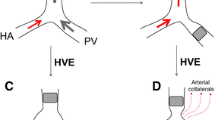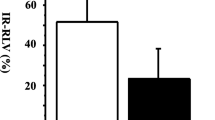Abstract
We studied, clinically and experimentally, hypertrophy of the part of the liver not embolized after portal vein embolization (PVE). The subjects of the clinical study were 29 patients with hepatocellular carcinoma (HCC) who underwent embolization of the right first portal branch; 19 patients had cirrhosis, and 10 did not. The volume of the liver was calculated from computed tomograms obtained before PVE and 2 weeks after. In all patients, the volume of the nonembolized (left) lobe increased significantly. For the experimental study, we used male Wistar rats. Normal rats were untreated, and in the other rats cirrhosis was induced with carbon tetrachloride. The portal branch that supplies 70% of the total volume of the liver was embolized. The rats underwent one of four procedures: 70% PVE, 70% portal vein ligation, 70% hepatectomy, or laparotomy only. Rats were killed at different times after surgery, and the livers were removed and weighed. The mitotic index and DNA synthesis were measured in the nonembolized lobe (PVE group), in the lobe not supplied by the ligated branch (ligation group), or in the remaining liver (hepatectomy group). The liver weight, mitotic index, and DNA synthesis were high in the PVE, ligation, and hepatectomy groups for both normal rats and rats with cirrhosis. PVE caused cell proliferation and hypertrophy in the nonembolized part of the liver in the normal rats and even in those with cirrhosis. We concluded that PVE can extend the surgical indications for patients with HCC and underlying cirrhosis.
Résumé
Une étude clinique et expérimentale de l'hypertrophie du foie controlatéral a été réalisée chez les patients ayant eu une embolisation portale sélective (EP), Dans l'étude clinique, parmi les 29 patients ayant un carcinome hépatocellulaire (CHC) et ayant eu une embolisation de la droit première branche porte, 19 avaient une cirrhose, 10 n'en avaient pas. Le volume du foie a été déterminé avant et 2 semaines après EP par tomodensitométrie. Chez tous les patients, le volume du lobe hépatique non embolisé (lobe gauche) a augmenté de volume de faÇon significative. Dans l'étude expérimentale, on a induit une cirrhose par ingestion de tétrachlorure de carbone chez des rats Wistar. La branche porte correspondant à 70% du volume total du foie a été embolisée. Quatre types d'interventions ont été réalisées: EP de 70% du volume hépatique, ligature de 70% du territoire hépatique, hépatectomie de 70%, ou laparotomie exploratrice. Les rats ont été sacrifiés 1 à 14 jours après l'intervention. Le poids hépatique, l'index de mitoses, et la syntèse en ADN étaient élevés chez les rats avec ou sans cirrhose. L'EP était associée à une prolifération cellulaire et une hypertrophie du lobe non embolisé chez les rats normaux ou cirrhotiques. On conclut que l'EP peut étendre les indications de résection chirurgicale chez le patient ayant un CHC associé à une cirrhose.
Resumen
Hemos estudiado la hipertrofia de la parte del hígado no embolizado después de embolización venosa portal (EVP) desde el aspecto clínico como experimental. La población del estudio estuvo constituído por 29 pacientes con carcinoma hepatocelular (CHC) sometidos a embolización de la primera derecha rama de la vena porta; 19 tenían cirrosis y 10 no eran cirróticos. El volumen del hígado fue calculado a partir de tomogramas computadorizados tornados antes de la EVP y dos semanas después. En todos los pacientes el volÚmen del lóbulo no embolizado aumentó en forma significativa. Se utilizaron ratas Wistar machos para el estudio experimental. Las ratas normales no recibieron tratamiento, y en las otras se indujo cirrosis con tetracloruro de carbono. La rama portal que irriga el 70% del volumen hepático total fue embolizada. Las ratas fueron sometidas a uno de cuatro procedimientos: 70% EVP, 70% ligadura de la vena portal, 70% hepatectomia o laparotomía simple; los animales fueron sacrificados a diferentes intervalos luego de la cirugía y los hígados removidos y pesados. Se determinaron el indice mitótico y la síntesis de DNA en el lóbulo no embolizado (grupo EVP), en el lóbulo no irrigado por la rama portal ligada (grupo ligadura) o en el hígado remanente (grupo hepatectomía). Tanto el peso del hígado como el indice mitótico y la síntesis de DNA aparecieron elevados en los grupos EVP, ligadura y hepatectomia tanto en ratas normales como en las cirróticas. La EVP causó proliferación celular e hipertrofia en la parte no embolizada del hígado en las ratas normales y aÚn en las ratas con cirrosis. Por consiguiente, la EVP amplifica las indicaciones quirÚrgicas en pacientes con CHC y cirrosis subyacente.
Similar content being viewed by others
References
Liver Cancer Study Group of Japan: Primary liver cancer in Japan: clinicopathologic features and results of surgical treatment. Ann. Surg.211:277, 1990
Rous, P., Larimore, L.D.: Relation of the portal blood to liver maintenance: a demonstration of liver atrophy conditional on compensation. J. Exp. Med.31:609, 1920
Honjo, I., Suzuki, T., Ozawa, K., Takasan, H., Kitamura, O., Ishikawa, T.: Ligation of a branch of the portal vein for carcinoma of the liver. Am. J. Surg.130:296, 1975
Kinoshita, H., Sakai, K., Hirohashi, K., Igawa, S., Yamasaki, O., Kubo, S.: Preoperative portal vein embolization for hepatocellular carcinoma. World J. Surg.10:803, 1986
Yamada, R., Sato, M., Kawabata, M., Nakatsuka, H., Nakamura, K., Takashima, S.: Hepatic artery embolization in 120 patients with unresectable hepatoma. Radiology148:397, 1983
Heymsfield, S.B., Fulenwider, T., Nordlinger, B., Barlow, R., Sones, P., Kutner, M.: Accurate measurement of liver, kidney, and spleen volume and mass by computerized axial tomography. Ann. Intern. Med.90:185, 1979
Steiner, P.E., Martinez, J.B.: Effects on the rat liver of bile duct, portal vein and hepatic artery ligations. Am. J. Pathol.39:257, 1961
Dotter, C.T., Goldman, M.L., Rosch, J.: Instant selective arterial occlusion with isobutyl 2-cyanoacrylate. Radiology114:227, 1975
Higgins, G.M., Anderson, R.M.: Experimental pathology of the liver. I. Restoration of the liver of the white rat following partial surgical removal. Arch. Pathol.13:186, 1931
Schneider, W.C.: Phosphorus compounds in animal tissues. III. A comparison of methods for the estimation of nucleic acids. J. Biol. Chem.164:747, 1946
Burton, K.: Determination of DNA concentration with diphenylamine. Methods Enzymol.12B:163, 1968
Kanashima, R., Nagasue, N., Furusawa, M., Inokuchi, K.: Inhibitory effect of cimetidine on liver regeneration after two-thirds hepatectomy in rats. Am. J. Surg.146:293, 1983
Liver Cancer Study Group of Japan: Survey and follow-up study of primary liver cancer in Japan: report 4. Kanzo20:433, 1979 [in Japanese]
Liver Cancer Study Group of Japan: Survey and follow-up study of primary liver cancer in Japan: report 9. Kanzo32:1138, 1991 [in Japanese]
Chuang, V.P., Wallace, S.: Hepatic artery embolization in the treatment of hepatic neoplasms. Radiology140:51, 1981
Schalm, L., Bax, H.R., Mansens, B.J.: Atrophy of the liver after occlusion of the bile ducts or portal vein and compensatory hypertrophy of the unoccluded portion and its clinical importance. Gastroenterology31:131, 1956
Kozaka, S.: Extensive hepatectomy in two stages: An experimental study. Arch. Jpn. Chir.32:99, 1963
DeWeese, M.S., Lewis, C., Jr.: Partial hepatectomy in the dog. Surgery30:642, 1951
Benz, E.J., Baggenstoss, A.H., Wollaeger, E.E.: Atrophy of the left lobe of the liver. Arch. Pathol.53:315, 1952
Kraus, G.E., Beltran, A.: Effect of induced infarction on rat liver implanted with Walker carcinoma 256. Arch. Surg.79:769, 1959
Hirono, T.: Effect of segmental interruption of portal venous blood supply on implanted tumor in the liver of rats. Arch. Jpn. Chir.33:526, 1964
Matsumoto, Y., Asakuma, R.: Effect of portal branch ligation on experimental tumor of the liver: immunological aspects. Jpn. J. Surg.3:106, 1973
Ozawa, K., Takasan, H., Kitamura, O., Mizukami, T., Kamano, T., Takeda, H., Ohsawa, T., Murata, T., Honjo, I.: Effect of ligation of portal vein on liver mitochondrial metabolism. J. Biochem.70:755, 1971
Kubo, S., Matsui-Yuasa, I., Otani, S., Morisawa, S., Kinoshita, H., Sakai, K.: Effect of portal branch ligation on polyamine metabolism in rat liver. Life Sci.38:1835, 1986
Murabayashi, K.: Experimental studies on the hepatic functional reserve in liver atrophy and regeneration after ligation of a branch of the portal vein. Kanzo28:214, 1987 [in Japanese]
Akasaka, Y.: Experimental studies on extension of resectability of the liver in dogs with special reference to an extended hepatectomy in two stages after ligation of the portal vein branch. Nippon Geka Gakkai Zasshi91:683, 1990 [in Japanese]
Matsuoka, T., Nakatsuka, H., Nakamura, K., Kaminou, T., Manabe, T., Yamada, T., Kobayashi, N., Onoyama, Y., Kinoshita, H., Hirohashi, K., Yamada, R.: Long-term embolization of the portal vein with isobutyl 2-cyanoacrylate for hepatoma. Nippon Igaku Housyasen Gakkai Zasshi46:72, 1986 [in Japanese]
Shibayama, Y., Saitoh, M., Hashimoto, K., Sakaguchi, Y., Ohi, G., Nakata, K.: Hepatic circulatory disturbance and reconstruction of vascular channels after obstruction of portal vein branches. Kanzo25:1121, 1984 [in Japanese]
Ishikawa, M., Yogita, S., Makuuchi, M.: Experimental studies on liver regeneration following transcatheter portal embolization. Nippon Shokaki Geka Gakkai Zasshi22:1084, 1989 [in Japanese]
Oguma, S.: Experimental studies of transcatheter portal embolization. Nippon Geka Gakkai Zasshi91:114, 1990 [in Japanese]
Nakao, N., Miura, K., Takahashi, H., Ohnishi, M., Miura, T., Okamoto, E., Ishikawa, Y.: Hepatocellular carcinoma: combined hepatic, arterial, and portal venous embolization. Radiology161:303, 1986
Makuuchi, M., Thai, B.L., Takayasu, K., Takayama, T., Kosuge, T., Gunven, P., Yamazaki, S., Hasegawa, H., Ozaki, H.: Preoperative portal embolization to increase safety of major hepatectomy for hilar bile duct carcinoma: a preliminary report. Surgery107:521, 1990
Islami, A.H., Pack, G.T., Hubbard, J.C.: Regenerative hyperplasia of the cirrhotic liver following partial hepatectomy. Cancer11:663, 1958
Author information
Authors and Affiliations
Rights and permissions
About this article
Cite this article
Lee, K.C., Kinoshita, H., Hirohashi, K. et al. Extension of surgical indications for hepatocellular carcinoma by portal vein embolization. World J. Surg. 17, 109–115 (1993). https://doi.org/10.1007/BF01655721
Issue Date:
DOI: https://doi.org/10.1007/BF01655721




